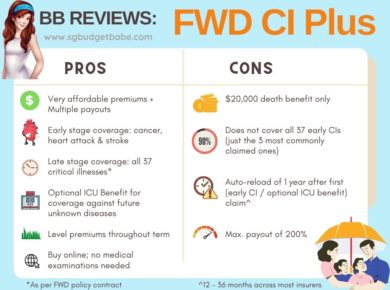With the recent change in critical illness definitions by the Life Insurance Association Singapore, can we expect more changes in the future? How will that impact us as policyholders, whose contracts are tied to the definitions prevailing during our time upon policy inception?
That was the biggest question on my mind recently after watching the hoo-ha unfold over social media, as consumers started complaining about insurance agents who tried to hard-sell them critical illness policies and make a decision before 26 August 2020.
Seeing the (seemingly) contradictory statements put out by MAS vs. the previous LIA statements did not help to make it any clearer, so I reached out to MAS to clarify…who then referred me to LIA.
After speaking to LIA, I’ve managed to get a satisfactory conclusion on the recent spate of changes, as well as the recourse that consumers have against bad egg agents.
Most importantly, if you’re wondering if future CI changes will also affect you, the short answer is yes, it may.
If the definitions become stricter, you can always try to contest a claim with your insurer by citing the (older) definitions stated in your policy. If the definitions become more inclusive (new conditions added, previous exclusions removed, etc), then you can always try to contest that with your insurer by citing the new definitions as well.
Ultimately, LIA’s stance is that the benefits to be paid will be based on the definitions and T&Cs stated in your policy. Your insurer will get to make the final call.
Earlier this month, I shared about how I called up my financial advisor to discuss the upcoming changes to LIA’s framework of critical illness definitions.
After the Zoom session, I went to download the LIA document that captured the changes and penned down my observations here. There was a lot of discussion on social media about unscrupulous insurance agents who were using the 26 August deadline to hard-sell critical illness policies, and MAS then addressed this issue, as reported in the Business Times.
So imagine my confusion when I compared the MAS vs. LIA statements, both of which appeared to be contradictory to one another:
- MAS: “there is no change to the intended scope of coverage when compared against CI definitions from 2014”
- LIA: “policyholders with existing illness policies are not impacted by the new definitions”, “all critical illness products based on definitions used from 2014 may no longer be sold in Singapore from Aug 26”
MORE CLARITY ON THE CHANGES
After reaching out to both MAS and LIA to clarify the contradictory statements, here’s what I learnt:
1. Consumers with existing CI policies based on the 2014 framework will not be impacted by the change in definitions, and insurers will still need to fulfil the terms in our contract for as long as our policy remains in effect.
LIA has confirmed this, saying that “claims assessment and benefits will follow the definitions, and the T&Cs stated in the policy contracts”.
2. The definitions seem to include stricter tests that are now required to confirm certain conditions before being eligible for a claim now, as compared to before. Is this correct?
No.
LIA has clarified that this is not the case, and that the tests are not necessarily stricter per se. Rather, there have been newer tests developed over the years, and the updated definitions thus serve to clarify whether certain tests can or cannot be used.
3. Bone marrow cancer that does not require recurring or major interventionist treatment will no longer be covered. Is this true?
No. The update in LIA’s newest definition is actually due to the latest reclassification of certain blood abnormalities by the medical field.
4. Stroke due to secondary haemorrhage within a pre-existing cerebral lesion will no longer be eligible for claims.
No. LIA has clarified that this was not covered in the 2014 definition either, since stroke due to secondary haemorrhage within a pre-existing cerebral lesion, infarction of brain tissue, cerebral and subarachnoid haemorrhage, intracerebral embolism, and cerebral thrombosis are not considered as “cerebrovascular incidents” in the first place.
Based on the original document, it appears that the 5 exclusions now are much stricter than the original 4, but LIA helped me understand that this is not the case. So I guess this could be one of those things that only a qualified medical specialist will be able to explain to us if we try to claim for it.
As it turns out, the definition change doesn’t mean that you could previously claim for this under 2014’s version – it simply adds more clarity to the definition.

Despite what the title seems to suggest, there is actually no change to the definition for heart valve surgery. Even though the 2014’s version did not have the words “Open Chest” in the title, it was still stated in the description below i.e. the 2014 definition similarly required an actual undergoing of an open chest surgery for a claim to be payable.
6. Multiple Sclerosis will now need to fulfil a stricter assessment criteria including multiple neurological deficits that occur over a continuous period of 6 months. Is this correct?
No. For this condition, the new changes are actually more beneficial to the consumer as the original condition of “a well documented history of exacerbations and remissions of said symptoms or neurological deficits” has now been removed.

7. Coronary artery disease will no longer cover diagnosis through non-invasive coronary angiography, and neither will branches of the coronary arteries be included. If consumers want to claim for this, will they now need to first prove the condition through invasive coronary angiography?
8. In the event that a consumer who was paid out a sum for Loss of Hearing can now have their hearing restored due to new medical technology, will they be required to refund the claims payout? If a medical advancement comes up 2 years later that now allows them to restore their hearing, will the consumer need to repay the payout?
No. So if your insurer tries to do that, remember that you don’t have to repay any claims that were already paid out for this.
9. For a consumer who has a policy incepted prior to 26 August 2020, can they file for a claim for a condition based on the 2014 LIA CI definitions instead?
Yes, if this was stated in your policy contract.
10. If my policy is based on past definitions, which have now become outdated due to LIA’s future definition changes, can I contest a claim with my insurer by citing the new definitions?
LIA: The benefits to be paid will be based on the definitions and T&Cs stated in your policy. The new definitions cannot be retrospectively applied to existing policies.
11. What recourse does a consumer have against an agent who wrongly communicated the implications of the new LIA definitions to them in their purchase of a new policy?
LIA has responded to me that if we believe there is a case of misrepresentation, then consumers can file a formal complaint of the alleged misrepresentation with the insurer concerned for an investigation to be conducted.
A huge thanks to LIA for taking the time out to respond to my questions, and clarify the confusions. Based on this, I would assume that there are bound to be future changes to critical illness definitions as well, and it may or may not be a bad thing.
When that happens, it might be a good idea to review your insurance coverage once more and ensure that all your needs are being met. While it may be tempting to get the highest possible coverage, a better approach is to go for the extent of coverage with premiums that you can afford without being squeezed too tight.
Don’t let any agent hard-sell you into buying a policy just because of this – when in doubt, you can always read the documents from LIA yourself.
With love,
Budget Babe








1 comment
This comment has been removed by a blog administrator.
Comments are closed.